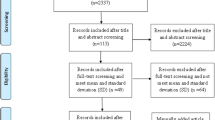Summary
Following a proposal of dose-response (D-R) relationships for various biochemical and haematological parameters in part I, this paper discusses D-R-relationships for subjective and functional responses and for chronic sequelae. Lead in blood levels (PbB) are regarded as “internal dose”. It appears not to be possible to suggest adequate D relationships; however various no-response levels could be suggested. The concept of no-response level and of D-R-relationship is reevaluated. Various interfering factors are mentioned, which allow only approximative answers in regard to no-response levels and place and/or shape of D-Rcurves. An overall view of the D-R-relationships presented endorses the previously proposed Biological Quality Guide for the distribution of PbB levels within a population group: adherence to this guide very probably will prevent any health impairment in children and adults.
Similar content being viewed by others
References
Alexieva, Z., Uscheva, G., Ivanova, S.: Über einige Kriterien zur Frühdiagnostik der Bleivergiftungen. Z.ges.Hyg.18, 191 (1972)
Betts, P.R., Astley, R., Raine; D.N. Lead intoxication in children in Birmingham. Brit.med.J.1973 I, 402
Blei and Umwelt. Berlin: Komm. für Umweltgefahren des Bundesgesundheitsamtes 1972
Bryce-Smith, D., et al., Landrigan, P.J., et al., David, O.J.- Letters to the editor. Lancet1974 I, 866, 1166
Bulpitt, C.J.: Lead and hyperactivity. Lancet1972 II, 1144
de la Burde, B., Choate McLin, S.: Does asymptomatic lead exposure in children have latent sequelae. J.Pediat.81, 1088 (1972)
Carson, T.L., van Gelder, G.A., Karas, G.C., Buck, W.B.: Slowed learning in lambs prenatally exposed to lead. Arch.environm.Hlth.29, 154 (1974)
Chisolm, J.J.: Treatment of lead poisoning. Mod.Treatment8, 593 (1971)
Cooper, W.C., Gaffey, W.R.: Mortality of workers in lead smelters and lead battery plants. Int.Symp.Recent Advances in the Assessment of Health Effects of Environmental Pollution, ECE-EPA-WHO, Paris (1974)
Cramer, K., Dahlberg, L.: Incidence of hypertension among lead workers. Brit.J.industr.Med.23, 101 (1966)
Cramer, K., Goyer, R.A., Jagenburg, R., Wilson, M.H.: Renal ultrastructure, renal function and parameters of lead toxicity in workers with different periods of lead exposure. Brit.J.industr.Med.31, 113 (1974)
David, O., Clark, J., Voeller, K.: Lead and hyperactivity. Lancet1972 II, 900
Goldberg, A.M., Silbergeld, E.K.: Low level lead toxicity. Int.Symp.Recent Advances in the Assessment of Health Effects of Environmental Pollution, ECE-EPA-WHO, Paris (1974)
Goyer, R.A.: Lead and the kidney. In: Current topics in pathology, Vol. 55, p. 147. Berlin: Springer 1971
Guinee, V.F., Davidow, B., Tytun, A.: Clinical and environmental correlations with blood lead levels of children in New York City. Int. Symp.Recent Advances in the Assessment of Health Aspects of Environmental Pollution, ECE-EPA-WHO, Paris (1974)
Hernberg, S.: Biological effects of low lead doses. In: Environmental health aspects of lead, p.617. Luxembourg: Comm.Europ.Commun. 1973
Hickey, R.J., Schoff, E.P., Clelland, R.C.: Relationship between air pollution and certain chronic disease death rates. Arch.environm.Hlth.15, 728 (1967)
Klein, M.C., Sayre, J.W., Kotok, D.: Lead poisoning; current status of the problem facing pediatricians. Amer.J.Dis.Child.127, 805 (1974)
Kotok, D.: Development of children with elevated blood lead levels; a controlled study. J.Pediat.80, 57 (1972)
Lansdown, R.G., Shepherd, J., Clayton, B.E., et a1.: Blood lead levels, behaviour and intelligence, a population study. Lancet 1974 I, 538
McNeil, J.I., Ptasnik, J.A.: Evaluation of long term effects of elevated blood lead concentrations in asymptomatic children. Int.Symp. Recent Advances of Environmental Pollution, ECE-EPA-WHO, Paris (1974)
Malcolm, D.: The effects of lead on the kidney. Trans.Soc.occup.Med.20, 50 (1970)
Malcolm, D.: Prevention of long-term sequelae following the absorption of lead. Arch.environm.Hlth.23, 292 (1971)
Morgan, B.B., Repko, J.D.: Evaluation of behavioral functions in workers exposed to lead. In: Behavioral toxicology, early detection of occupational hazards, C. Xintaras et al., eds., p. 248. Washington: U.S.Dept. Health, Education and Welfare 1974
NAS: Comm. on biological effects of atmospheric pollutants. Lead; airborne lead in its perspective. Washington: Nat.Acad.Science 1972
Panova, Z.: Early changes in the ovarian function of women in occupational contact with inorganic lead. In: Works of the United Research Institute of Hygiene and Industrial Safety, Vol.23, p. 167, Sofia (1972)
Peuschel, S.M., Kopito, L., Schwachmann, H.: Children with an increased lead burden. J.Amer.med.Ass. 222, 462 (1972)
Sakurai, H., Tugita, M., Tsuchija, K.: Biological response and subjective symptoms in low level lead exposure. Arch.environm.Hlth.29, 157 (1974)
Seppälainen, A.M.: Peripheral nervous system in lead exposed workers. In: Behavioral toxicology, early detection of occupational hazards, C. Xintaras et al., eds., p. 240. Washington: U.S.Dept. of Health, Education, and Welfare 1974
Seppäläinen, A.M., Hernberg, S.: Sensitive technique for detecting subclinical lead neuropathy. Brit.J.industr.Med.29, 443 (1972)
Stopps, G.J., Maxfield, M.E., McLaughlin, M., Pell, S.: Lead research; current medical developments. In: Trans. 31st ann.meeting, Industr.Hyg. Found.Amer. Pittsburgh, Pa. (1966)
Szadkowski, D., Schaller, K.H., Radunski, K.: Das Verhalten des Blutbleispiegels bei einigen internen Krankheiten. Arbeitsmed.Sozialmed.Arbeitshyg.4, 54 (1969)
Waldron, H.A., Stöfen, D.: Subclinical lead poisoning. London: Academic Press 1974
Warren, H.V.: Environmental lead: a survey of its possible physiological significance. J.biosoc.Sci.6, 223 (1974)
Westerman, M.P., Bruetman, M., Pfitzer, E.: Lead poisoning and multiple sclerosis. Arch.environm.Hlth.29, 355 (1974)
Wiener, G.: Varying psychological sequelae of lead ingestion in children. Publ.Hlth.Rep.85, 19 (1970)
Zaworski, R.E., Oyasu, R.: Lead concentration in human brain tissue. Arch.environm.Hlth.27, 383 (1973)
Zielhuis, R.L.: Biological quality guide for inorganic lead. Int.Arch. Arbeitsmed.32, 103 (1974)
Zielhuis, R.L.: Dose-response relationships for inorganic lead.I.Biochemical and haematological responses. Int. Arch. Occup.Hlth35, 1 (1975)
Zielhuis, R.L., Verberk, M.M.: Validity of biological tests in epidemiological toxicology. Int.Arch.Arbeitsmed.32, 167 (1974)
Author information
Authors and Affiliations
Rights and permissions
About this article
Cite this article
Zielhuis, R.L. Dose-response relationships for inorganic lead. Int. Arch Occup Environ Heath 35, 19–35 (1975). https://doi.org/10.1007/BF01266324
Received:
Accepted:
Issue Date:
DOI: https://doi.org/10.1007/BF01266324




